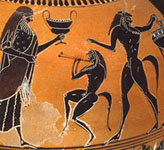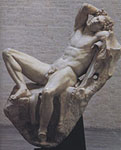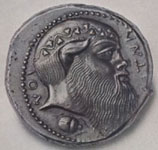Satyrs



Rustic demons and attendants of the wine god
Dionysos, shown as men with horses' (and later goats') tails, animal ears and coarse features. Archaic east Greek
satyrs often have horses' legs or hoofs. They are often shown drunken or sexually aroused and pursue
Maenads. They help
Dionysos fight the
Giants and are especially prominent in the procession returning
Hephaistos to
Olympos. In later art satyr children and even women are shown. Other figures of satyr type are
Silenos (an alternative name for
satyrs) and
Marsyas.
Above left: Detail from an Ionian black-figure clay vase, about 530 BC. Niarchos Collection, Athens. © Niarchos Collection
Above middle: Marble sleeping satyr (the so-called 'Barberini faun'). Early second century BC. Munich, Staatliche Antikensammlunen, 218 © Staatliche Antikensammlunen, Munich
Above right: C.M.Kraay, Greek Coins pl. II. © Kraay.


